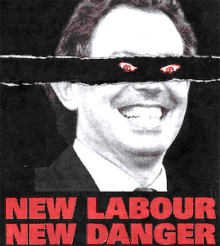
New Labour, New Danger was an advertising campaign run in the United Kingdom by the Conservative Party during the run up to the 1997 general election. It was conceived by creative director Martin Casson[1] at advertising agency M&C Saatchi, and refers to the Labour Party's "New Labour" slogan.[2]
Design
The main poster used in the campaign involved a picture of Labour Party leader Tony Blair on a black background with a strip of the poster appearing to be torn off across the eyes of Blair. The eyes were replaced with a pair of "demon eyes" with the slogan "New Labour New Danger" positioned below the picture.[3]
A later poster used the "demon eyes" on a purse and accompanied it with the slogan "New Labour, New Taxes".[4]
Response
The advert was praised by Campaign, who judged it had completed its objective of questioning Blair's character. The advertisement was claimed to have gained the Conservatives £5 million worth of free publicity.[5] Despite being declared 'the best advert of the year' it was widely condemned as counter productive.[6]
The advert was condemned by the Labour Party as negative advertising.[7] In September 1996, former Conservative prime minister Edward Heath also criticized the advert.[8] The Conservatives went on to experience their worst election defeat for more than half a century, with some journalists speculating that the poster contrasted unfavourably with Labour's more positive campaign.[9]
The Advertising Standards Authority received 150 complaints about the Blair advert, including one from the Bishop of Oxford. The ASA upheld the complaints and instructed the Conservatives to withdraw the poster, stating they believed it portrayed Blair as "dishonest and sinister"[4] and also because the campaign did not have Blair's permission to use his image.[10] In 1999, the ASA decided to stop regulating political advertising, citing this advert as a particularly difficult case and saying: "The free flow of argument in the cut and thrust of open debate is the best antidote to political advertising that misleads or offends."[11] A poll by the poster site company Maiden Outdoor found 64 per cent disliked the campaign.[12]
Legacy
In August 2012, it was announced that the "demon eyes" design would be used in the American film The Campaign.[13]
The Labour Party's workers founded an amateur football team called Demon Eyes F.C. named after the adverts. The football team once won Thames League Division 1, before being disbanded.[14]
References
- ↑ "martincasson.carbonmade.com". Martin Casson Portfolio. 2022-08-04. Retrieved 2022-08-04.
- ↑ Carlin, Brendan (2006-09-05). "Saatchis aren't working for the Tories". London: Telegraph. Retrieved 2012-09-14.
- ↑ "New Labour, New Danger - Demon eyes (Conservative, 1997)". London: Guardian. Retrieved 2012-09-14.
- 1 2 Paul Routledge (1996-09-01). "Tories revive 'demon eyes'". The Independent. London. Archived from the original on 2022-06-18. Retrieved 14 September 2012.
- ↑ Andrew Culf (10 January 1997). "Demon eyes ad wins top award". London: Guardian. Retrieved 2012-09-14.
- ↑ Porter, Andrew (2008-03-17). "The power of political advertising". London: Telegraph. Archived from the original on 2012-03-31. Retrieved 2012-09-14.
- ↑ "Labour fights back at Tory 'new danger' posters". Campaign. 1996-08-02. Retrieved 14 September 2012.
- ↑ "Heath damns 'demon eyes' poster". The Independent. London. 1996-09-08. Archived from the original on 2022-06-18.
- ↑ "Obama and Romney second debate: Are slogans and soundbites helpful?". 15 October 2012.
- ↑ Paul McCann (1997-09-01). "Ad watchdog washes its hands of Demon Eyes". The Independent. London. Archived from the original on 2022-06-18. Retrieved 14 September 2012.
- ↑ "Annual Report 1999". Advertising Standards Authority. Retrieved 14 September 2012.
- ↑ "Demon eyes ad wins top award". The Guardian Newspaper. 10 January 1997.
- ↑ "Hilton's demon eyes are perfect for Hollywood". Evening Standard. 2012-08-31. Retrieved 14 September 2012.
- ↑ Rayner, Gordon (2008-03-15). "The team of winners with a strong left wing". London: Telegraph. Retrieved 14 September 2012.
